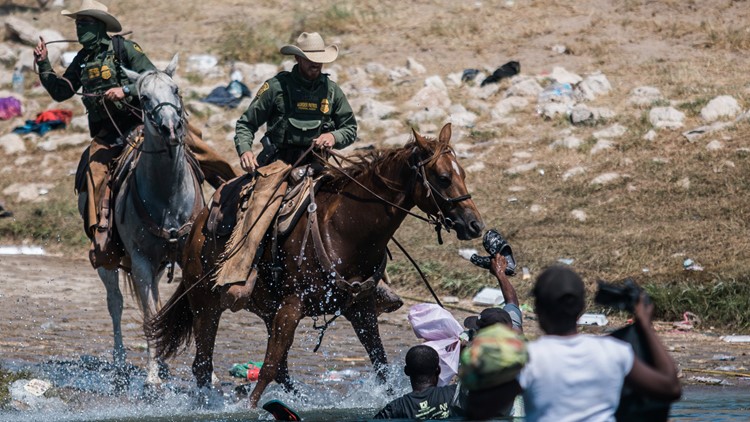Over the weekend, photos and videos were shared of the United States-Mexico border in Del Rio, Texas, where thousands of migrants, primarily from Haiti, were encamped.
One photo that was shared widely on social media also got the attention of VERIFY viewers. The picture shows a U.S. Border Patrol agent on horseback chasing after two migrants, grabbing one of them by the shirt. Viral tweets, like this one shared more than 35,000 times, alleged the Border Patrol agent was using a whip.
VERIFY viewers were wondering if the widely-shared photo, seen in the tweet below from Rep. Sheila Jackson Lee, was real and from the U.S. southern border.
THE QUESTION
Are the photos of U.S. Border Patrol agents on horseback chasing migrants real?
THE SOURCES
- RevEye Reverse Image Search
- Getty Images
- Vice President Kamala Harris
- Alejandro Mayorkas, secretary of the Department of Homeland Security
- Jen Psaki, White House press secretary
THE ANSWER
Yes, the photos of U.S. Border Patrol agents on horseback chasing migrants are real.
WHAT WE FOUND
The photo cited by Rep. Jackson Lee was taken by photographer Paul Ratje. A reverse image search using RevEye traced the image back to several news articles that credit the photo, available from Getty Images, to Ratje. The caption of the photo on Getty Images says it was taken on Sept. 19, 2021. No results for the photo were found by VERIFY before that date.
Ratje described what he saw to NPR.
"The agents tried to block [the migrants], and then the one agent grabbed a man by his shirt and then kind of swung them around," he said.
Ratje also spoke with Politifact.
"Nobody saw a Border Patrol agent whipping," he said. "What we did see was a Border Patrol agent swinging the rein in like a circle. It looked pretty threatening. Nobody saw him strike the migrant with that thing, the reins.
That picture, as well as other images from the border, have raised concerns about the treatment of the migrants, which the Department of Homeland Security (DHS) says are predominantly Haitian.
People on social media have accused agents of using whips. DHS secretary Alejandro Mayorkas contested that allegation during a news conference on Sept. 20, saying Border Patrol agents have long reins to control the horses. One video appears to show a Border Patrol agent swinging horse reins as they block migrants.
Jon Anfinsen, National Border Patrol Union vice president, spoke with TV station KVUE.
“They don't have whips. They have reins," Anfinsen said. "But the reins, they have to keep them moving, both as a deterrence to keep people away from the horse, because if they get too close to the horse, they might spook it and they get stepped down or trampled, but also as a means to prevent people from grabbing onto the reins. Now, there's nobody that was trying to grab the reins, but it's a thing they constantly do because they have to maintain control of the reins and the horse. If they lose control of the horse, people get hurt, people get stepped on.”
DHS tweeted that U.S. Customs and Border Protection is investigating.
“We are going to investigate the facts to ensure that the situation is as we understand it to be, and if it’s anything different we will respond accordingly,” Mayorkas said.
U.S. Customs and Border Protection says horse patrol units are sent to areas other patrol units can’t reach.
“Horse Patrol Agents ride in challenging terrain, environmentally protected, and privately owned sensitive geographic locations,” the agency says on its website. “The Horse Patrol are the most viable, and, in some cases, the only option for the U.S. Border Patrol to enter into regions inaccessible by any other means of patrol, such as 4x4 vehicles or All-Terrain Vehicles (ATVs).”
During a Senate Homeland Security and Government Affairs Committee hearing on Sept. 21, Mayorkas said he was “horrified” by some of the images being shared online.
Vice President Kamala Harris, who President Joe Biden tasked with addressing migration at the southern U.S. border, also condemned the actions of Border Patrol agents seen in photos and videos.
“What I saw depicted of those individuals on horseback treating human beings the way they were was horrible,” said Harris, who also supported an investigation.
White House press secretary Jen Psaki said President Biden “believes that the footage and photos are horrific.”
Haiti is struggling with a wide range of issues from human rights violations, to the July 2021 assassination of its president, to a devastating Aug. 2021 earthquake that came 11 years after an earthquake in the country killed close to 300,000 people. The U.S. lists Haiti as a Level 4 “Do Not Travel” country due to kidnapping, crime, civil unrest and COVID-19.
Last week, there were about 13,000 to 15,000 migrants, primarily Haitian, encamped in the border town of Del Rio, Texas, according to Mayorkas. During the Sept. 21 Senate committee hearing, he said the number of migrants at that border point had fallen below 10,000.
Mayorkas partially attributed the rapid increase in Haitian migrants to misinformation that they will be allowed in the U.S.
Haitians already in the U.S. before July 29 can apply for temporary protected status, which if granted, means they are eligible to legally stay and work in the U.S. through Feb. 3, 2023. U.S. Citizenship and Immigration Services estimates 155,000 people will be eligible to apply for temporary protected status under the designation of Haiti.
However, Haitian migrants now crossing the southern border into the U.S. are being expelled, according to Mayorkas.
Psaki said expulsions will continue under a policy called Title 42, first implemented in response to the COVID-19 pandemic by the Trump administration and continued by the Biden administration, which allows the government to turn away migrants as part of the effort to limit the spread of COVID-19.
Mayorkas said the migrants in Del Rio, Texas, are being moved to other immigration processing centers as needed “so they can be repatriated to Haiti and other countries.”



